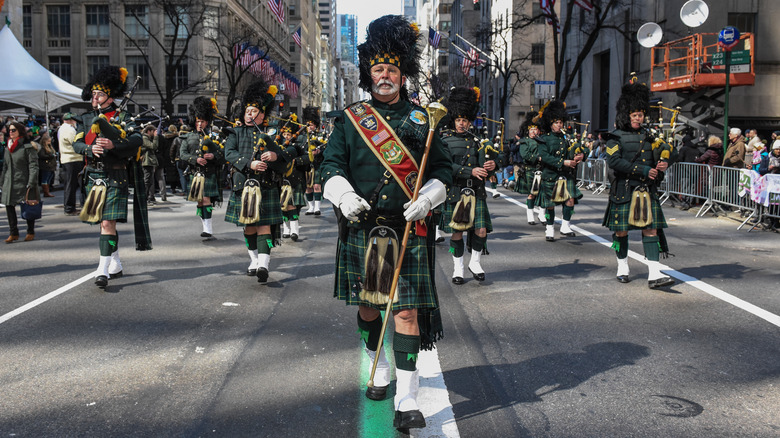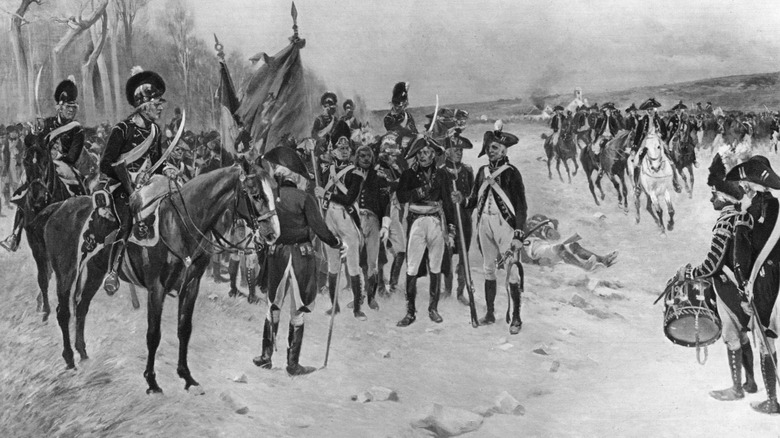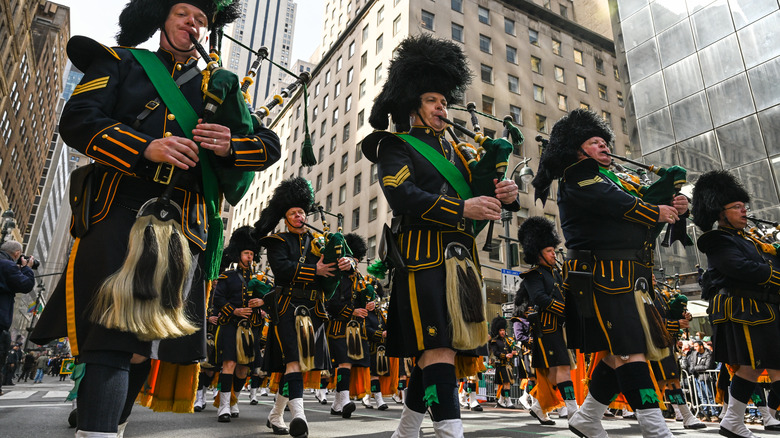You're A Rebel If You Wear Green On St. Patrick's Day. Here's Why
Green was not Saint Patrick's color. Depictions of Patrick going back to the 13th century put him in robes of blue. Blues of various shades have been associated with Ireland as well as its patron saint throughout history; Henry VIII's break with Catholicism birthed the Irish coat of arms of a gold harp on a blue backdrop, and a light shade of sky blue used by George III for the chivalric Order of St. Patrick is still known as St. Patrick's Blue. Flaitheas Éireann, an equivalent figure to Uncle Sam, sometimes wore blue robes in depictions just as St. Patrick did. Even today, blue is used in some official capacities; copies of the Irish constitution are bound in it.
This is all likely to come as a surprise to anyone whose knowledge of Irish color association derives from St. Patrick's Day. In Dublin and Galway, in New York, Chicago, and Boston — in cities all over the world — St. Patrick's is a holiday marked by green. It's another color with a long presence in Irish history. Green's an easy descriptor of the island itself; it's not called the "Emerald Isle" for any native source of the gemstone, which isn't naturally produced in Ireland. The green shamrock is also what St. Patrick used, according to legend, to explain the Trinity to the Irish.
But green's displacement of blue in the popular mind as Ireland's color didn't come along on account of landscape or flora. Green became associated with religious and national pride and grew into the color of rebellion even as St. Patrick's Day itself morphed from a religious holiday to a celebration of Irish heritage.
The Rebellion of 1798 linked green to St. Patrick's Day
St. Patrick's Day as a March 17 holiday was fixed on the liturgical calendar in the early 1600s according to New Advent, though feasts commemorating Patrick were observed in Ireland as early as the 9th century. As a holiday within Lent, it was seized upon as an excuse to be free of Lenten prohibitions, and the Catholic Church turned to the green shamrock to reinforce the day's intended meaning. At the time, the color most associated with Saint Patrick and Ireland was still blue, but there was a custom of plucking shamrocks to place in one's lapel on the holiday.
A Catholic uprising in 1641 saw an army out of Kilkenny use a green flag with a gold harp. But it was the Rebellion of 1798, begun that February, that most helped tie green to the idea of Irish rebellion from Britain. The fight of 1798 was a brief one; per the Museum of the American Revolution, it only lasted five months. But it was an early push by the Irish for a republican government, inspired by the recent examples of America and France.
The French Revolution provided inspiration of a different kind. Just as revolutionaries in France donned distinctive caps, the Society of United Irishmen had their own unique clothing at a time when military uniforms took on symbolic importance. A police report (via Alexander Maxwell's "Patriots Against Fashion") described the Irish rebel uniform as a dark green coat with green and white-striped trousers and a shamrock as the rebels' device.
Politics and patriotism popularized green
The Rebellion of 1798 inspired "The Wearing of the Green," a street ballad sung to the tune of an older melody. The most popular set of lyrics use the shamrock as a symbol of Irish identity and explicitly tie it and the color green to Saint Patrick, himself a symbol of Ireland in the song. This version of the lyric was written by the playwright Dion Boucicault, who mixed defiance of the British with resignation; the final verse in his version is a call for emigration to the United States. It was in America that the link between Irish identity and green was reinforced, as immigrants adopted the color to show pride in their heritage.
Back in the home country, the blue long associated with Saint Patrick was falling out of favor as the divide between Ireland and Britain widened. The religious feud in Ireland gave green another association; it was embraced by the Catholics as a way to stand apart from the unionist, orange-coded Protestants. The white of peace separating the two colors on the modern Irish flag was a long time in coming.
Today, despite what St. Patrick's Day decorations (and a plethora of sports uniforms) might lead one to believe, there is no national color for Ireland. Whatever hostility some might have had to the blue used under British rule, the Irish government retained it and the gold harp for the national coat of arms. But it's green that lingers in the popular imagination, and continues to find use; The Irish Times tied the green of St. Patrick's Day to Ireland's environmental efforts in 2023.


